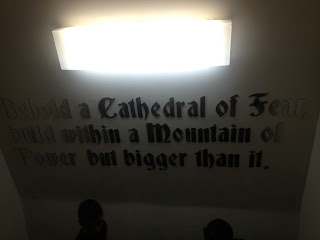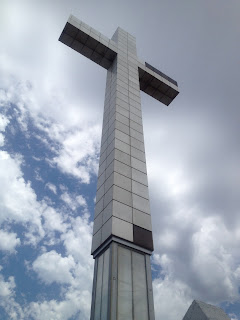 |
| Pictures of candles lit in Serbian Orthodox monastery (where we met Dragon). |
Maybe we are all just candles floating in water waiting for our wicks to burn out.... Wow that was deep and depressing (deepressing?).
Picking up from where the last post left off, we had a free day on Thursday, July 12, because of an unfortunate death in the family of the person who we were scheduled to meet (we rescheduled for Friday at 5, so I will get to it). I made use of the day by going for a run, doing some laundry, visiting one of the mosques and getting some delicious dinner (not to mention getting drenched by the rain after dinner).
Friday the 13th was packed. We started out with a visit to the Court of Bosnia and Herzegovina at 10 am. We met with a couple of the international judges, one of whom is a Northeastern alum. After hearing some great insight on the justice system of Bosnia and Herzegovina, as well as the politics wrapped up in it, we paid a visit to the US Embassy in Sarajevo. There we spoke with the head of the political division for the embassy. He shared with us one of the most interesting and innovative reconciliation programs for students in BiH. The State Department got a group of Bosniaks, Croats and Serbs together and shipped them to a high school in the US. By the end of their stay, they went from only associating with other members of their ethnic group to associating with people of other ethnic groups. The logic was to put the Balkan students in an environment that where their divisions and history were irrelevant and they were cultural outsiders. This forced them to become each other's social network and support. Just like this trip is putting things in perspective for me, their trip gave them a completely new perspective.
Our last engagement of the 13th was a meeting with a former Serbian soldier and Sarajevo native. We met him at an old (we're talking about 5 centuries old) Serbian Orthodox monastery right by one of our hotels (incidentally, this is also the site of the first casualty of the Siege of Sarajevo). He told us a compelling story about how the war separated him from his best friend, a Bosniak Muslim. Before the war, they had been best friends and enrolled in the same university after high school. The war interrupted their university education in 1992. The Serb, Dragon, was able to smuggle his friend and his family out of the Serbian controlled Sarajevo into Bosniak controlled Sarajevo. Dragon even gave his friend his life savings. As time went on, they both joined their respective armies, but Dragon would use a contact in the Red Cross to send over supply packages from time to time.
After the war, Dragon tried to return to his apartment in Sarajevo. When he was back in Sarajevo, he ran into his old friend, who he had not seen in 7 years. His friend was with three other Bosniaks. The four of them beat Dragon senseless while Dragon's father, too old to help, watched from their car. A couple years later, Dragon ran into his friend's father and asked where his son was. Dragon was told that his friend had probably gone to Afghanistan because he had been radicalized. Some time after he found this out, Dragon received a call from his friend's father, who informed Dragon that his Bosniak friend had been killed in Afghanistan. Apparently his last words to his father were that Dragon had been the best friend he had ever had.
On Saturday, July 14, we embarked to Mostar at 2 pm. On the way, we stopped at Tito's bunker from the Cold War. It is open to the public now and has been used to host art exhibits over the past couple years. Some of the exhibits are still in place. Here's a couple pictures from our tour (most of them are art exhibitions that have been left in place. Also, please forgive the formatting. Blogger is being particularly frustrating right now):
 |
| Picture from the communication center |
Art exhibit close to Tito's office in the bunker.
|
 |
Supposedly.
Picture from the fuel tank room. The exhibition is by a Finnish artist. It is meant to be red rain falling down on shoulders (there is another large tank on the right side of the room).
We also visited Jablanica, which is where the "Battle of the Neretva" was filmed and where the WWII battle took place between the Partizans and the Natzis. Here's a picture of the bridge wreckage that has been left since the filming of the movie:
|

**********************************************************
On Sunday, July 15th, I went for a hike with some fellow students. We followed some streets, a stretch of highway and a path up to a cross erected by some Croat Catholics. It was a fun hike, even if it was pretty warm. The place where the cross is was at the top of one of the hills overlooking Mostar. It was also one of the main Croat artillery positions during the war, so there were a couple signs up indicating where there are still active land mines. Anyway, here are a couple pictures from that excursion:

After the hike, we were given a short tour and history lesson by one of our TA's former instructors and friend. He explained the religious, linguistic and cultural dynamics in Mostar, which manifest in interesting architecture. Once you get up on one of the hills, you can see the red orange roofs of mostly Bosniak homes and the other buildings of mostly Croats. Although we stopped our lesson by a small Serbian Orthodox church and graveyard, Serbs are in the minority in Mostar.
The church happened to be on the other hill overlooking Mostar, which is where the Serbs were positioned during the war. Apparently, since the Bosniaks were trapped in the city in the valley below, without artillery, the Bosniak commander would occasionally call the Serbian commander with coordinates of Croat positions. Sometimes the Serbs would charge for the shelling and sometimes it was on the house. I think this is an excellent example of the absurdities of the war, especially because the Croats and Bosniaks would eventually side with each other to take on the Serbs.
The next morning, before heading back to Sarajevo then north to Belgrade, we met with a program manager from the National Dialogue Center in Mostar. The NDC's in Mostar, Sarajevo, Belgrade, Zagreb, etc., are largely funded by the Norwegian government. Because of some miscommunication, our meeting was cut short, but we got to hear some encouraging stories about how they are working to integrate schools. I think I've mentioned it before in my blog, but many of the schools in BiH are segregated based on ethnicity. NDC has had some success, but there are still a lot of hearts and minds to win over.
I will have to stop here for now. Dinner is calling. In my next post, I'll get to Belgrade.







No comments:
Post a Comment